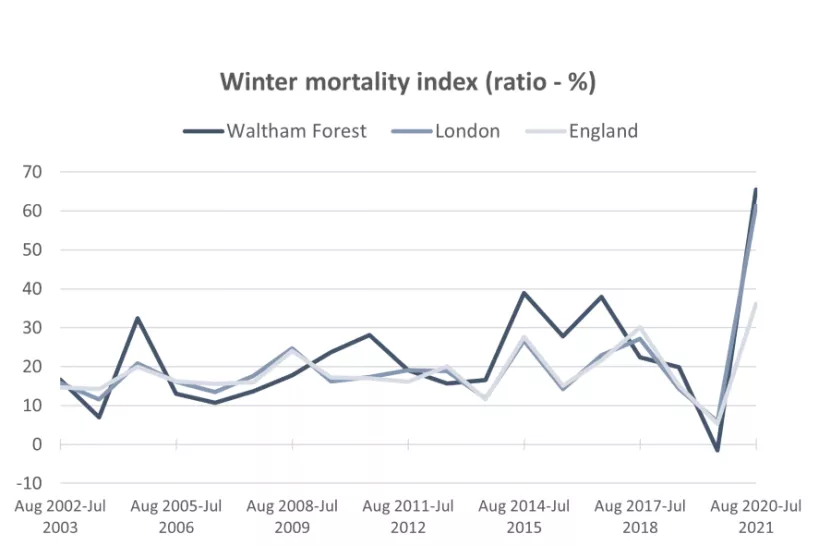Last updated: 15 August 2023
Next review: 17 July 2024
This content is part of the Waltham Forest JSNA. To see other JSNA content, visit the JSNA landing page
Cold weather has significant impacts on health and wellbeing and is the cause of a significant number of deaths across the UK each year. There are a range of direct negative impacts associated with cold weather (such as increased rates of heart attack, stroke, falls and injuries, and circulation of respiratory infections like influenza and COVID-19), as well as indirect effects such as poor mental health. Certain populations are at particular risk from the impacts of cold weather, including older adults, young children, those with long-term health conditions, and those living in poor quality, cold homes. [1]
The excess winter deaths index compares the number of deaths from all causes that occurred in the winter period (December to March) with the average number of deaths in the non-winter periods (August to November and April to July). Most excess winter deaths are due to circulatory and respiratory diseases and the majority occur in older adults. [2]
In 2020, the coronavirus (COVID-19) pandemic led to a large increase of deaths mostly in the non-winter months of April to July 2020. Because this indicator relies on using the difference between deaths occurring in the winter and the average of non-winter months; specifically, the scale of COVID-19 deaths during non-winter months has fundamentally disturbed the data time series and so data for 2019 to 2020 should be interpreted with caution.
Between August 2020 to July 2021, there were 65.5% more deaths in the winter period in Waltham Forest, which was significantly above the England average (36.2%). The previous year (2019 to 2020) was the only winter where there was a negative winter mortality index (meaning that fewer people died in winter months relative to the rest of the year). Both of these extremes are largely due to the COVID-19 pandemic, with the largest numbers of deaths falling outside of winter months in 2019 to 20 and within winter months in 2020 to 2021.

Source: OHID Public Health Outcomes Framework. Data from Office for National Statistics: Annual Births and Mortality Extracts. Date accessed: 7 July 2023.
The relationship between winter deaths and deprivation is the opposite to that observed with premature mortality, as the ratio increases as deprivation decreases. This is due to winter deaths disproportionately affecting older adults, with those in less deprived groups more likely to live to an age that makes excess winter mortality more likely compared with those in more deprived deciles. [3]
References
[1] Public Health England (2020). Health matters: cold weather and COVID-19. Date accessed: 7 July 2023.
[2] OHID Fingertips - Public Health Outcomes Framework. Date accessed: 4 June 2023.
[3] OHID Fingertips - Public Health Outcomes Framework. - inequalities. Date accessed: 4 June 2023.